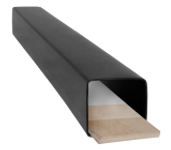About this product
The 2KS Common Dormouse Drey has been specifically designed for Common Dormice. With a body length of 6 - 9 cm, a weight of approx. 15 - 40 g and a tail of almost equal length, the common dormouse is the smallest variety of dormouse found in Central Europe. It is severely endangered over much of this range, and in many cases has completely disappeared from it. For this reason, in accordance with FFH directives, this animal and its habitats enjoy special protection in all member states of the European Union. The 2KS Common Dormouse Drey has been field tested and is ideal for supporting and monitoring dormouse populations. After occupying the box dormice are very territorial, and their territory will extend between 150 and 200 m from the drey.
One of the main advantages of the KS is that the entrance is at the rear, facing the tree trunk, making it more difficult for birds to occupy it (it is important to ensure that the trunk is of the right diameter). With upper, lower and side openings next to the trunk the actual access is ideally positioned but still well protected from potential predators.
Suitable for;
Common dormice. The smaller entrance hole (26mm) compared to the 1KS General Purpose Dormouse Drey (entrance hole of 40mm) and the integrated barrier makes access difficult or even impossible for other species.
Installation
To protect common dormice, especially in areas where edible dormice are present in large numbers, it is important to ensure a maximum distance between the back of the drey and the tree trunk of 2.5 cm to 3 cm. This can be ensured by selecting trees with a diameter of approx. 20cm - 30 cm. Experience has shown that several dreys can be hung up at a distance of 30 m to 50 m from each other. Depending on the success of efforts to attract occupants, this distance can also be increased.
Suitable sites
Dry broadleaf and mixed coniferous and broadleaf woodlands, with widely spaced trees. Provided there is plenty of available food, woodlands consisting predominantly of conifers may also be suitable. These animals tend to establish themselves well in woodland (frequently on the edges of woods, or where wind breakage or replanting have occurred), and with dense undergrowth and shrubs. This provides a good source of food. Meadows interspersed with fruit trees or large, wild gardens also offer a habitat for dormice, provided there is woodland nearby. It is advisable to hang the boxes between holes and cavities already occupied by birds to avoid unnecessary disturbance by birds seeking nesting sites. Ideally the boxes should be placed at a height of 1.5 - 3 m above the ground.
Material
Weather-resistant, air-permeable Schwegler wood concrete with a galvanized mounting strap.
Method of attachment
Patented Schwegler hanger, including aluminium nails which have been approved for forestry use. The back of the drey is rounded, matching the shape of the trunk and ensuring a secure attachment.
Cleaning and inspection
The front panel is removable to enable quick and easy checks to be carried out. It is not necessary to remove the drey from the tree. IMPORTANT: do not disturb overwintering animals!
Advantages of the 2KS drey
* Suspension method and materials approved for forest use.
* Patented, central suspension method prevents box from becoming ingrown.
* Safe, long-lasting (25+ years) and weather-resistant.
* A quality product with extensive field testing.
Dormice Information
Dormice are mainly found in broadleaf and mixed woodland that is not at risk of flooding, as well as in wild gardens and meadows interspersed with fruit trees. Dormice are now severely under threat (in some cases they are on the Red List of endangered species). The far-reaching destruction of what were formerly widely distributed, natural and open woodlands with their relatively high proportion of fallen trees has deprived these animals of an ideal habitat. Their disappearance leads to a severe ecological imbalance.
Dormice are excellent climbers and tend to be active at dusk and during the night. They rest during the day, safe in their nests, which are usually spherical in shape and made of moss, ferns, grasses, leaves and small twigs, and may be hidden in holes in trees, such as those made by woodpeckers, in clefts in the rock or in thickets. However, such ideal sites are often not available, and so they are competing increasingly with birds for nesting holes.
Due to this shortage of quarters experts advise hanging up special boxes, known as dreys, for these species. Depending on the locality, dormice can hibernate for up to 7 months, surviving on fat reserves built up during the summer. They also require a dry and safe place in which to conceal themselves.
Specification
External Dimensions: 295 H X 175 W X 225 D mm
Internal Dimensions: 125 x 125 mm
Weight: 6.2kg
Hole diameter: 26 mm
Material: Schwegler's patented Woodcrete, which is an exceedingly durable, rot-proof and breathable natural material designed to mimic the properties of natural nest sites and last 25+ years.
Customer Reviews























